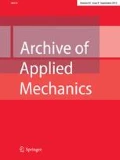Abstract
Newton’s law of motion is derived from Kepler’s laws of planetary motion. This is achieved by applying a simple system identification method using numerical data from the planet’s orbits in conjunction with the inverse square law for the attractive force between celestial bodies and the concepts of the derivative and differential equation. The identification procedure yields the differential equation of motion of a body under the action of an applied force as stated by Newton. Moreover, the employed procedure, besides validating the inverse square law, permits the evaluation of the gravitational mass (standard gravitational parameter), paving thus the way for establishing Newton’s law of universal gravitation. As the employed mathematical tools and the theory were available before 1686, we are allowed to state that the equation of motion for a body with constant mass could have been established from Kepler’s law of planetary motion, before Newton had published his law of motion.



Similar content being viewed by others
References
Newton, I.: Philosophiae Naturalis Principia Mathematica. Royal Society Press, London (1686)
Newton, S.I.: The Mathematical Principles of Natural Philosophy; Translated into English by Andrew Motte, published by Daniel Adee, New York (1846)
Katsikadelis, J.T.: Derivation of Newton’s law of motion using Galileo’s experimental data. Acta Mech. (2015). doi:10.1007/s00707-015-1354-y
Murray, C.D., Dermott, S.F.: Solar System Dynamics. Cambridge University Press, Cambridge (1999)
Ince, E.L.: Ordinary Differential Equations. Dover, New York (1956)
Sasser, J. E.: History of ordinary differential equations: The first hundred years. In: Proceedings of the Midwest Mathematics History Society (1992)
Katsikadelis, J.T.: System identification by the analog equation method. In: Brebbia, C.A. (ed.) Boundary Elements XVII, pp. 33–44. Computational Mechanics Publications, Southampton (1995)
Boyer, C.B.: History of Analytic Geometry, Scripta Mathematica. Yeshiva University, New York (1956)
NASA Planetary Comparison Chart. http://solarsystem.nasa.gov/planets/compchart.cfm. Retrieved 6 June 2015
Solar System Dynamics, Astrodynamic Constants, Jet propulsion Laboratory, California Institute of Technology. http://ssd.jpl.nasa.gov/?constants. Retrieved 6 June 2015
Solar System Dynamics, Planetary Satellite Mean Orbital Parameters, Jet propulsion Laboratory, California Institute of Technology. http://ssd.jpl.nasa.gov/?sat_elem
Angel, R., Plastino, A.R., Muzzio, J.C.: On the use and abuse of Newton’s second law for variable mass problems. Celest. Mech. Dyn. Astron. 53(3), 227–232 (1992). Kluwer Academic Publishers
Hadjidemetriou, J.D.: Two-body problem with variable mass: a new approach. Icarus 2, 440–451 (1963)
Bogîldea, S.: On the problem of the two-bodies. Romanian Rep. Phys. 64(1), 294–301 (2012)
Author information
Authors and Affiliations
Corresponding author
Rights and permissions
About this article
Cite this article
Katsikadelis, J.T. Derivation of Newton’s law of motion from Kepler’s laws of planetary motion. Arch Appl Mech 88, 27–38 (2018). https://doi.org/10.1007/s00419-017-1245-x
Received:
Accepted:
Published:
Issue Date:
DOI: https://doi.org/10.1007/s00419-017-1245-x




